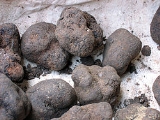
Tuberaceae
Encyclopedia
The Tuberaceae are a family
of mycorrhizal fungi. It includes the genus Tuber
, which includes the so-called "true" truffles. It was characterized by the Belgian botanist Barthélemy Charles Joseph du Mortier in 1822. A molecular study of ribosomal DNA
by mycologist Kerry O'Donnell in 1997 found that a small clade
now redefined as Helvellaceae
is most closely related to the Tuberaceae.
Family (biology)
In biological classification, family is* a taxonomic rank. Other well-known ranks are life, domain, kingdom, phylum, class, order, genus, and species, with family fitting between order and genus. As for the other well-known ranks, there is the option of an immediately lower rank, indicated by the...
of mycorrhizal fungi. It includes the genus Tuber
Tuber (fungus)
Tuber is a genus of truffle in the Tuberaceae family. According to a standard reference text, the widespread genus contains 86 species....
, which includes the so-called "true" truffles. It was characterized by the Belgian botanist Barthélemy Charles Joseph du Mortier in 1822. A molecular study of ribosomal DNA
Ribosomal DNA
Ribosomal DNA codes for ribosomal RNA. The ribosome is an intracellular macromolecule that produces proteins or polypeptide chains. The ribosome itself consists of a composite of proteins and RNA. As shown in the figure, rDNA consists of a tandem repeat of a unit segment, an operon, composed of...
by mycologist Kerry O'Donnell in 1997 found that a small clade
Clade
A clade is a group consisting of a species and all its descendants. In the terms of biological systematics, a clade is a single "branch" on the "tree of life". The idea that such a "natural group" of organisms should be grouped together and given a taxonomic name is central to biological...
now redefined as Helvellaceae
Helvellaceae
The Helvellaceae are a family of ascomycete fungi, the best known members of which are the elfin saddles of the genus Helvella. Originally erected by Elias Magnus Fries in 1823 as Elvellacei, it contained many genera...
is most closely related to the Tuberaceae.

